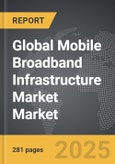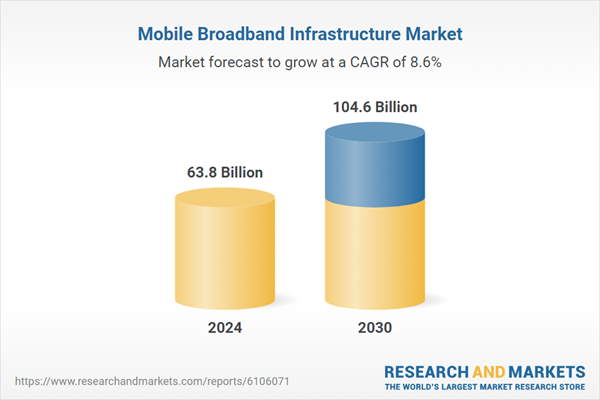Global Mobile Broadband Infrastructure Market - Key Trends & Drivers Summarized
How Is Mobile Broadband Infrastructure Transforming Global Connectivity?
Mobile broadband infrastructure has emerged as the backbone of global digital communication, enabling the high-speed wireless transfer of data across urban, rural, and remote regions. This infrastructure comprises a complex ecosystem of base stations, radio access networks (RAN), core networks, fiber backhaul, towers, and power systems, which work in tandem to deliver seamless mobile internet services. With increasing smartphone penetration and mobile-first economies rising, especially in Asia-Pacific and Sub-Saharan Africa, the demand for resilient and scalable broadband networks is rapidly accelerating. Service providers are deploying more distributed antenna systems (DAS), small cells, and edge computing nodes to address urban congestion and reduce latency, while rural expansion strategies focus on cost-effective macro cell upgrades and satellite-based backhaul solutions.Another critical transformation stems from the evolution of wireless technologies. The transition from 4G LTE to 5G has significantly altered infrastructure demands, necessitating densification of the network, spectrum reallocation, and software-defined networking (SDN). Furthermore, open RAN (O-RAN) architecture is gaining popularity for its vendor-agnostic capabilities, reduced capex, and improved network intelligence. This modular, cloud-native infrastructure allows operators to manage networks with greater agility while fostering a competitive vendor ecosystem. Innovations in MIMO (Multiple Input, Multiple Output), beamforming, and network slicing are enhancing capacity and spectral efficiency, pushing the limits of what mobile broadband networks can deliver across verticals such as autonomous transport, industrial automation, and smart cities.
What Key Technology Shifts Are Reshaping Infrastructure Investments?
The convergence of mobile broadband infrastructure with digital technologies such as artificial intelligence, machine learning, and cloud-native platforms is significantly shaping the future of investments in this space. AI-powered network management is enabling real-time monitoring, predictive maintenance, and automated fault detection, leading to a drastic reduction in downtime and operational costs. Network virtualization, especially through technologies like NFV (Network Functions Virtualization), is replacing traditional hardware-based functions with software solutions, allowing for dynamic resource allocation and faster service delivery.Edge computing is another pivotal shift, reducing latency and improving data handling by processing information closer to the end-user. This is especially relevant for applications in IoT-heavy sectors such as smart manufacturing, autonomous vehicles, and telemedicine, where even microseconds matter. Telcos and infrastructure providers are collaborating with hyperscale cloud players to establish edge nodes across regional clusters, accelerating content delivery and real-time analytics. Simultaneously, the integration of low-earth orbit (LEO) satellite constellations is redefining coverage possibilities in previously underserved geographies. These multi-layered network enhancements collectively aim to balance coverage, capacity, cost, and continuity across diverse terrains and user demands.
How Are Regulatory Trends and Sustainability Goals Impacting Deployment?
The deployment of mobile broadband infrastructure is also being shaped by shifting regulatory frameworks and growing environmental concerns. Governments worldwide are pushing for universal broadband access as part of their digital inclusion agendas, which has led to increased public-private partnerships and funding initiatives. Spectrum auctions and regulatory mandates on net neutrality, infrastructure sharing, and rural rollout obligations are influencing how and where investments are being directed. In many regions, policies are being introduced to streamline site acquisition, lower license fees, and encourage infrastructure co-location, all of which facilitate faster network buildouts.Environmental sustainability is now a core part of infrastructure design and planning. Energy-efficient base stations, renewable-powered tower sites, and the adoption of low-carbon construction materials are becoming standard. Companies are also increasingly committing to carbon neutrality targets, integrating circular economy principles in their supply chains, and recycling e-waste generated from network upgrades. These efforts align with broader ESG (Environmental, Social, and Governance) benchmarks that investors and stakeholders increasingly scrutinize. This dual focus on regulatory compliance and sustainability is fostering a more resilient, equitable, and responsible broadband ecosystem.
What Is Fueling the Accelerated Growth in Mobile Broadband Infrastructure?
The growth in the mobile broadband infrastructure market is driven by several factors closely tied to technological progression and evolving end-use demands. The continued rollout of 5G networks is a primary catalyst, requiring dense and distributed infrastructure capable of supporting ultra-high bandwidth and ultra-low latency. Use-case expansion into AR/VR, telehealth, online education, and digital payment ecosystems is pushing mobile operators and infrastructure providers to enhance both coverage and capacity. The proliferation of IoT devices in sectors like agriculture, mining, logistics, and public safety is generating demand for robust and scalable wireless backbone systems.Another strong driver is the increase in mobile data consumption globally, driven by video streaming, social media, and hybrid work trends. This has made network quality a competitive differentiator, encouraging investment in high-speed upgrades and next-gen transmission technologies. In addition, emerging markets are witnessing aggressive telecom expansion backed by government mandates and private equity funding, further boosting infrastructure demand. Cloud-native orchestration tools and AI-led network optimization strategies are improving operational efficiency, enabling telcos to manage higher loads with reduced complexity and cost. As such, the convergence of next-gen connectivity standards, diversified application landscapes, and strategic regulatory frameworks is propelling rapid advancements in mobile broadband infrastructure worldwide.
Report Scope
The report analyzes the Mobile Broadband Infrastructure market, presented in terms of market value (US$). The analysis covers the key segments and geographic regions outlined below:- Segments: Component (Hardware Component, Software Component); End-Use (Telecom Operators End-Use, Government End-Use, Enterprises End-Use).
- Geographic Regions/Countries: World; United States; Canada; Japan; China; Europe (France; Germany; Italy; United Kingdom; Spain; Russia; and Rest of Europe); Asia-Pacific (Australia; India; South Korea; and Rest of Asia-Pacific); Latin America (Argentina; Brazil; Mexico; and Rest of Latin America); Middle East (Iran; Israel; Saudi Arabia; United Arab Emirates; and Rest of Middle East); and Africa.
Key Insights:
- Market Growth: Understand the significant growth trajectory of the Hardware Component segment, which is expected to reach US$75.6 Billion by 2030 with a CAGR of a 9.9%. The Software Component segment is also set to grow at 5.6% CAGR over the analysis period.
- Regional Analysis: Gain insights into the U.S. market, valued at $17.4 Billion in 2024, and China, forecasted to grow at an impressive 13.6% CAGR to reach $23 Billion by 2030. Discover growth trends in other key regions, including Japan, Canada, Germany, and the Asia-Pacific.
Why You Should Buy This Report:
- Detailed Market Analysis: Access a thorough analysis of the Global Mobile Broadband Infrastructure Market, covering all major geographic regions and market segments.
- Competitive Insights: Get an overview of the competitive landscape, including the market presence of major players across different geographies.
- Future Trends and Drivers: Understand the key trends and drivers shaping the future of the Global Mobile Broadband Infrastructure Market.
- Actionable Insights: Benefit from actionable insights that can help you identify new revenue opportunities and make strategic business decisions.
Key Questions Answered:
- How is the Global Mobile Broadband Infrastructure Market expected to evolve by 2030?
- What are the main drivers and restraints affecting the market?
- Which market segments will grow the most over the forecast period?
- How will market shares for different regions and segments change by 2030?
- Who are the leading players in the market, and what are their prospects?
Report Features:
- Comprehensive Market Data: Independent analysis of annual sales and market forecasts in US$ Million from 2024 to 2030.
- In-Depth Regional Analysis: Detailed insights into key markets, including the U.S., China, Japan, Canada, Europe, Asia-Pacific, Latin America, Middle East, and Africa.
- Company Profiles: Coverage of players such as Adidas AG, Bad Boy, Century Martial Arts, Combat Sports Inc., Everlast Worldwide and more.
- Complimentary Updates: Receive free report updates for one year to keep you informed of the latest market developments.
Some of the 47 companies featured in this Mobile Broadband Infrastructure market report include:
- ADTRAN, Inc.
- Alcatel-Lucent Enterprise
- Airspan Networks, Inc.
- Ciena Corporation
- Cisco Systems, Inc.
- CommScope Holding Company, Inc.
- Cradlepoint, Inc.
- Ericsson AB
- Fujitsu Network Communications
- Huawei Technologies Co., Ltd.
- Juniper Networks, Inc.
- Mavenir Systems, Inc.
- NEC Corporation
- Nokia Corporation
- Qualcomm Technologies, Inc.
- Samsung Electronics Co., Ltd.
- ZTE Corporation
- Inseego Corp.
- Parallel Wireless, Inc.
- Comba Telecom Systems Holdings Co. Ltd.
This edition integrates the latest global trade and economic shifts into comprehensive market analysis. Key updates include:
- Tariff and Trade Impact: Insights into global tariff negotiations across 180+ countries, with analysis of supply chain turbulence, sourcing disruptions, and geographic realignment. Special focus on 2025 as a pivotal year for trade tensions, including updated perspectives on the Trump-era tariffs.
- Adjusted Forecasts and Analytics: Revised global and regional market forecasts through 2030, incorporating tariff effects, economic uncertainty, and structural changes in globalization. Includes historical analysis from 2015 to 2023.
- Strategic Market Dynamics: Evaluation of revised market prospects, regional outlooks, and key economic indicators such as population and urbanization trends.
- Innovation & Technology Trends: Latest developments in product and process innovation, emerging technologies, and key industry drivers shaping the competitive landscape.
- Competitive Intelligence: Updated global market share estimates for 2025, competitive positioning of major players (Strong/Active/Niche/Trivial), and refined focus on leading global brands and core players.
- Expert Insight & Commentary: Strategic analysis from economists, trade experts, and domain specialists to contextualize market shifts and identify emerging opportunities.
Table of Contents
Companies Mentioned (Partial List)
A selection of companies mentioned in this report includes, but is not limited to:
- ADTRAN, Inc.
- Alcatel-Lucent Enterprise
- Airspan Networks, Inc.
- Ciena Corporation
- Cisco Systems, Inc.
- CommScope Holding Company, Inc.
- Cradlepoint, Inc.
- Ericsson AB
- Fujitsu Network Communications
- Huawei Technologies Co., Ltd.
- Juniper Networks, Inc.
- Mavenir Systems, Inc.
- NEC Corporation
- Nokia Corporation
- Qualcomm Technologies, Inc.
- Samsung Electronics Co., Ltd.
- ZTE Corporation
- Inseego Corp.
- Parallel Wireless, Inc.
- Comba Telecom Systems Holdings Co. Ltd.
Table Information
| Report Attribute | Details |
|---|---|
| No. of Pages | 281 |
| Published | December 2025 |
| Forecast Period | 2024 - 2030 |
| Estimated Market Value ( USD | $ 63.8 Billion |
| Forecasted Market Value ( USD | $ 104.6 Billion |
| Compound Annual Growth Rate | 8.6% |
| Regions Covered | Global |







